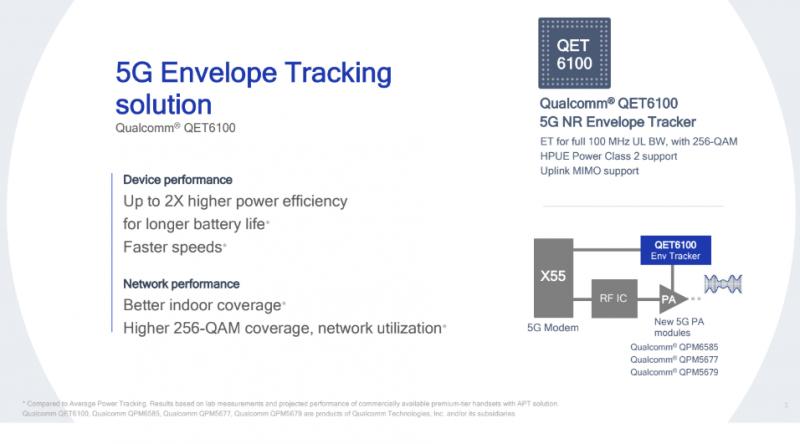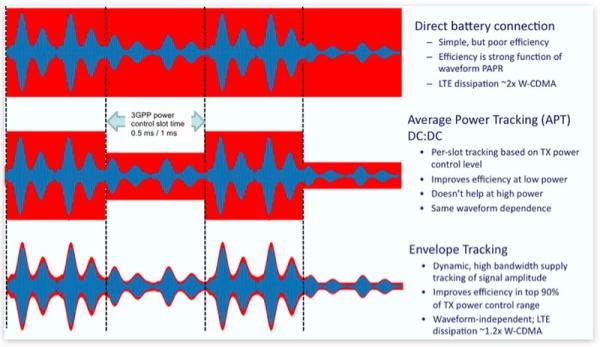
Migrating to 5G: The Envelope Tracking Power Solution
While the telco industry is well advanced down the road of migrating from LTE to 5G, there are plenty of challenges remaining—not the least of which is the specific power requirements involved in 5G networks. The scale of the challenge is only set to grow in the coming years, with a recent IDC report predicting that worldwide, 5G and LTE router/gateway markets alone will grow to about $3.0 billion by 2024 from about $979.3 million in 2019. One specific power-related technology that is enjoying a day or two in the sun is envelope tracking.
Envelope tracking (ET) can be traced back to 1952, when one Leonard Kahn proposed a technique called envelope elimination and restoration (EER) to improve the efficiency of SSB transmitters. Envelope tracking has fewer drawbacks than EER, but offers similar efficiency enhancements. In spite of this, ET was not implemented for some years due to its complexity—especially in wide bandwidth signal scenarios. However, ET is increasingly popular among mobile phone designers as a method to improve power amplifier efficiency.
This efficiency is derived from the fact that most modern wireless communications standards such as 5G, LTE and 802.11ac Wi-Fi have a high peak to average power ratio (PAPR). A fixed supply power amplifier (PA) must use a supply voltage high enough to support that peak power, but is only operating at maximum efficiency at the very peak, with the voltage being higher than needed the rest of the time, resulting in unnecessary heat generation in the PA—not only wasted energy, but a design challenge to remove it. ET ensures that the PA is running at an optimum level by dynamically adjusting the supply voltage according to the instantaneous amplitude of the signal.
While the basis of ET techniques might not be brand-new, there are plenty of examples of ET in current 5G networks, and indeed the concept is a core part of some of the latest and most cutting-edge hardware in the public domain. For example, Qualcomm’s newest fourth-gen Snapdragon X65 Modem-RF System has been in the headlines as a frontrunner in breaking the 10 Gbps barrier—a key tipping point where mobile broadband can genuinely match the speed of terrestrial fiber.

Qualcomm’s latest announcement breaks the 10 Gbps barrier with the Snapdragon X65 Modem-RF System, which incorporates a seventh generation wideband envelope tracker QET7100. This ET delivers 30% better power efficiency compared to the best alternatives (according to Qualcomm), a potentially valuable saving for designers. Qualcomm points out this “enables reduced board footprint”—a key concern for all implementations, but particularly for IIoT scenarios, where battery life is often a key concern.
Of course, power efficiency concerns are not limited to battery-powered environments. Even with the peak efficiency of modern switch mode power supplies (SMPS) sitting comfortably between 85% up to 95%, efficiencies are still welcome, not least in higher output power scenarios (more than 150 W), where the need for forced-air cooling may become a necessary part of the design.
Solving this challenge in a 5G context is front of mind for many engineers—so much so that the U.S. Department of Defense has awarded the University of Houston’s Power Electronics, Microgrids & Subsea Electrical Systems Center a $1.7 million grant to develop enhanced envelope tracking for 5G networks, a research project dubbed “5G comet,” in partnership with New Edge Signal Solutions.
As the university states: “[5G] roll out in the U.S. and elsewhere has been stymied by gaps in available technology that could operate at the high frequencies required by 5G.” The solution, according to the researchers, is to develop a 5G-specific envelope tracking power supply that can operate with a bandwidth of 100 MHz or higher— considerably greater than current envelope bandwidth in commercial applications.
The road to 5G and beyond contains many hardware challenges, which will require pushing existing concepts to their limits, as well as originating entirely new techniques to manage spectrum, power and heat challenges. Clearly envelope tracking is set to play a significant role in the future of our communication networks, especially as pressure on efficiency in both physical size and power use will continue to grow.
In addition, the likely application of improved envelope tracking and related power efficiencies will have trickle-down impact and spur innovation in different vertical industries, such as medical power supplies and many more. Truly, this is one area where the phrase “pushing the envelope” moves beyond figurative language into a pragmatic statement of fact.
Philip Lechner is the European product marketing manager for Power at Avnet Abacus, which helps design engineers with the latest technological challenges, including developments in optimizing and refining switched mode power supplies and techniques to limit inrush current.
}})